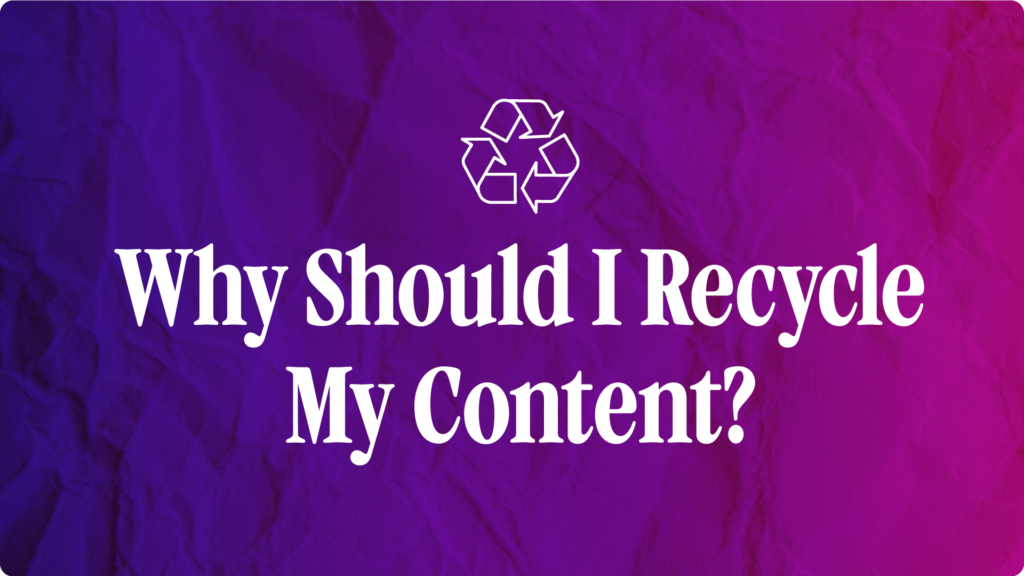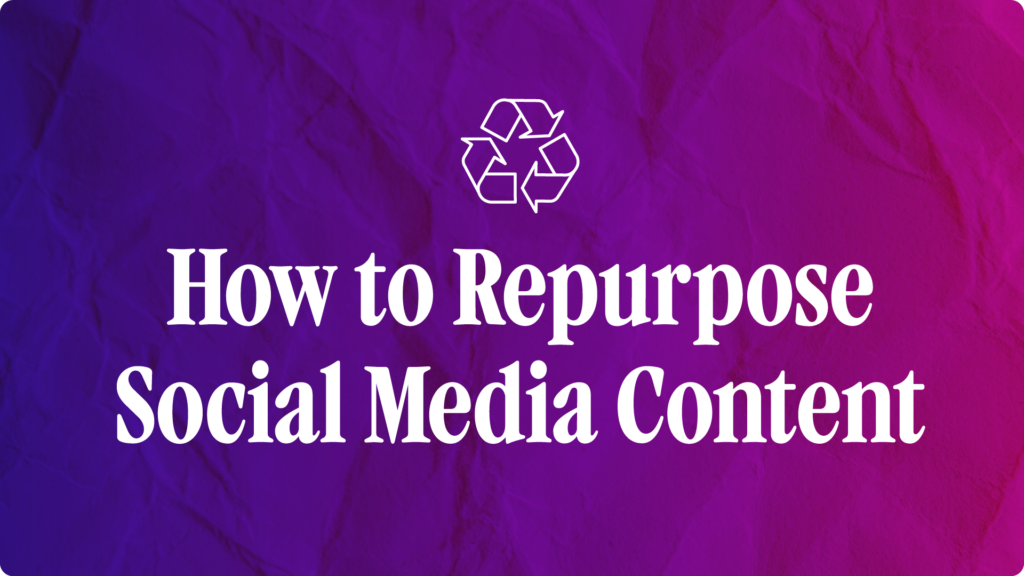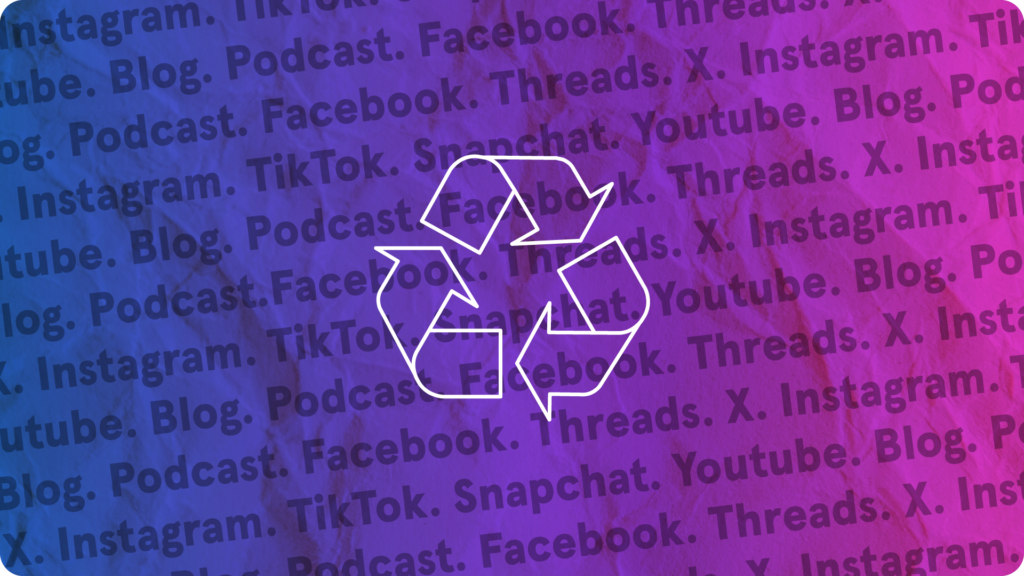by Lee Dussinger
Paper, plastic, and even glass – you feel great about recycling all of those. Simply drop any one of these items in the appropriately marked bin – and go about your day knowing you did the right thing! However, when it comes to recycling social media posts, you might be unsure if you should do it…or even how to do it well.
Recycling social media content is an effective way to do more with less – while delivering exactly what your audience wants to see. When discussing recycling or repurposing content, we’re talking about transforming a previously published post into something different enough to publish again.
Opal is the marketing platform that numerous Fortune 500 brands use to create their content. Since many of the most talented marketers in the world use Opal to execute their content strategies, we have a front row seat to how they do content. For many industry-leading brands, recycling social media posts is a key part of their strategy. That’s why we’re putting this effective yet misunderstood tactic into the spotlight.
We’re breaking down how to repurpose social media content to drive more impact with less effort. Keep reading to see the 5 steps to repurposing content like the very best – and see how the right tools make this even more efficient.
Why Should I Recycle My Content?

In 2023, there’s still some confusion about recycling content. Some marketers have the impression that reusing content isn’t a valid strategy for social performance. Others have the impression that “real” marketers and “real” brands would never do it. Lastly, some even think that it’s “cheating” in some way.
We’ll say it once and for all – repurposing content isn’t bad – it’s GREAT, in fact! Here are the benefits of recycling for you (the marketer), the brand you represent, and the audience:
- For you, repurposing proven content enables you to have a broader reach with limited time and resources. Rather than developing 100% original content all the time, you get to re-leverage something that worked the first time around. So, you enjoy the ease of use and the confidence in knowing you’re doing what worked.
- One of the most common mandates of marketing leadership and executives is that their teams need to do more with less. You’re doing exactly that. You invested time and creativity into this the first time around – maximizing that same investment to earn additional social impressions is great for business.
- While your audience wouldn’t find value in exact carbon copies of content, you’re putting a twist on the content to make it valuable again. This is something you know the audience liked before – now you’re giving them more of a good thing. Also, considering how social media algorithms restrict content, much of your audience may not have even seen the original content.
If you do it right, there’s no downside to repurposing social media content. We just want to note that recycling social media posts needs to be done with intention and care to create something equally as valuable as the first asset. Here’s how we recommend you implement this practice.
How to Repurpose Social Media Content [5 Steps]

When repurposing social media content for maximum impact, you’ll want to follow a precise set of guidelines. While executing this process isn’t complex by any means, it is more involved than just copying and pasting old content haphazardly.
Here’s how to repurpose social media content like enterprise brands:
1. Identify the Content (Using Data) – You want to be as sophisticated as possible when selecting the content to repurpose. After all, you’re looking to maximize your impact with high-value content – not just clog your feed with filler. Depending on the level of sophistication in your analytics motion, this may be very simple. Essentially, you want to only select the top performing social media content to repurpose. So, the more content you produce, the more selective you can be in setting your criteria for what to reuse.
When looking for the right content to repurpose, we recommend pulling from content that had success along multiple axes. For example, a post that earned superior levels of organic engagement is likely worth recycling – just like a post with great ROI.
2. Figure Out Why It Worked – You have identified a piece of content that performed well according to one or more essential criteria. Now, the goal is to understand why. Maybe it was the striking images, maybe it was the topic, maybe it was the lead statistic – or maybe it was just speaking to the specific audience. Ultimately, once you understand why the content worked, you can plan out the changes you’ll make. Of course, this judgment call isn’t an exact science – you’re making an estimate based on your instincts as a marketer and your knowledge of your audience.
3. Make Changes – When repurposing content for impact, you’ll generally want to change at least one of the core elements. Essentially, the goal is to make the content feel different enough that if someone saw both the recycled post and the original, they wouldn’t feel like they saw a duplicate. These are the most common things to change when repurposing social media content:
- Different images
- Different copy
- Different copy format
- Different testimonial/quote
- Different statistic
Of course, in some cases, changing how you deliver the content will drive the most impact. This can look like one or more of the following strategies:
- Posting the content to a different social platform
- Posting the content to a different location (with a regional account)
- Using different hashtags
- Selecting a different audience (if using paid)
- Posting the content to a different brand (that you also manage)
- Posting in a different language (learn more about AI marketing translation)
4. Schedule Your Post – Now that you have a recycled content asset ready to hit the market (again), it’s time to schedule. Using a visual content calendar for managing your social media presence is essential for enterprise brands. This way, you can ensure that any post (repurposed or not) is published at the perfect time. Plus, a central calendar is an ideal method to give visibility across the entire organization to ensure brand alignment across social media.
5. Measure Again – Now that you have a freshly recycled post, you’ll do exactly what you did the first time around: measure the results. If the piece of content performed as well or better than the first time around, it may be a candidate for further repurposing. However, if you find the impact lacking, it may be time to archive this particular piece of content.
Tools Needed for Content Recycling (Especially At-Scale)
When creating a few posts per week, content recycling is a simple and straightforward matter. Of course, when your brand has a fairly modest appetite for content, the need for effective repurposing will be less as well.
However, when working at-scale, the correct software tools make the recycling process more precise and more efficient. Here’s what you need:
Space to store content – When you’ve identified a piece of content as successful, you need a space to store and stage it for rewriting. Opal customers often use our free-form planning space Boards to save top performing content. This gives teams a central space to store content and the edits that will enable successful repurposing.
Dedicated content calendar – A central visual calendar is an essential method for marketing organizations to visualize how their audience is experiencing their brand or their brands. A good calendar should showcase what content is going live, at any given date and time. When repurposing content, a calendar is necessary to understand how the repurposed content fits alongside your fresh content.
See more about the opal visual marketing calendar right here.
True-to-life previews – This is an essential piece of what makes for enterprise-grade social media software. Whether you’re creating social content the first time or repurposing it, you need to see your posts exactly as your audience will. Having disconnected text and images in a Google doc is just not good enough. An effective social platform will be identical to what you’d see if you were working in the native platform.
AI editing and rewriting tools – AI can be very effective when recycling social posts at-scale. Opal’s AI Rewrite tool enables our customers to transform their copy in a second. AI Rewrite gives strategists the ability to redo their content with a different tone or using completely different ideas or strategies. Increasingly, AI is going to be a game-changer when repurposing large batches of content.
Analytics tool – The final thing you likely need to be able to execute this strategy is the analytics tool. There are a variety of high-quality options that can save and store the performance metrics of each post, enabling you to always have access to the info you require to make decisions. The best of these tools also integrates with the platform where you plan, create, and calendar your social content.
Explore the Opal Platform in Depth
Opal is a tool used by big brands like Target, SAP, Starbucks, and GM to plan their holistic brand and marketing experiences, including social media. Recycling content is just one way that customers use Opal. However, it is a very powerful and unique use case, which is why we featured it here.
Ready to see Opal’s potential? Request a demo from our expert team or sign up for a free 14-day trial to explore all the features. Join the ranks of the biggest brands in the world with Opal!


